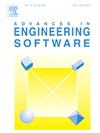Layout optimization design method for thermo-elastic thin-walled structures with lattices and stiffeners
IF 5.7
2区 工程技术
Q2 COMPUTER SCIENCE, INTERDISCIPLINARY APPLICATIONS
引用次数: 0
Abstract
This work proposes a layout optimization design method for thermo-elastic thin-walled structures with lattices and stiffeners in the framework of multi-material topology optimization, in which both the steady-state temperature field and mechanical loads are considered. Firstly, taking into account the design requirements, suitable lattice unit cells are chosen and their equivalent mechanical properties are obtained by the homogenization method. Thus, the candidate lattice unit cells are represented as corresponding virtual homogeneous materials. Meanwhile, the stiffeners are modelled with solid material. Afterwards, a multi-material thermo-elastic structural optimization formulation is established and solved iteratively through gradient-driven optimization algorithms to obtain the optimized layouts of the lattices and stiffeners. In addition, the maximum size constraint and the overall volume constraint with a lower bound are introduced. The former ensures that the solid material takes the form of 'ribs' in the optimization results and the latter could meet the requirement that the design space is filled with lattice or solid material. Finally, numerical tests are conducted to demonstrate the detailed application process and validate the effectiveness of the proposed design method. This work provides an effective design tool for the application of additively manufactured lattice structures in thermo-elastic coupled load-bearing structures.
带有加劲肋的热弹性薄壁结构布局优化设计方法
本文提出了一种在多材料拓扑优化框架下兼顾稳态温度场和机械载荷的格筋热弹性薄壁结构布局优化设计方法。首先,根据设计要求,选择合适的点阵单元,并采用均匀化方法获得其等效力学性能;因此,候选晶格单元被表示为相应的虚拟均质材料。同时,用固体材料对加强筋进行建模。然后,建立了多材料热弹性结构优化公式,并通过梯度驱动优化算法进行迭代求解,得到了优化的格和加强筋布局。此外,还引入了最大尺寸约束和带下界的总体体积约束。前者确保固体材料在优化结果中以“肋”的形式存在,后者可以满足设计空间以晶格或固体材料填充的要求。最后,通过数值试验验证了该方法的具体应用过程,验证了该设计方法的有效性。本工作为增材制造晶格结构在热弹性耦合承重结构中的应用提供了有效的设计工具。
本文章由计算机程序翻译,如有差异,请以英文原文为准。
求助全文
约1分钟内获得全文
求助全文
来源期刊

Advances in Engineering Software
工程技术-计算机:跨学科应用
CiteScore
7.70
自引率
4.20%
发文量
169
审稿时长
37 days
期刊介绍:
The objective of this journal is to communicate recent and projected advances in computer-based engineering techniques. The fields covered include mechanical, aerospace, civil and environmental engineering, with an emphasis on research and development leading to practical problem-solving.
The scope of the journal includes:
• Innovative computational strategies and numerical algorithms for large-scale engineering problems
• Analysis and simulation techniques and systems
• Model and mesh generation
• Control of the accuracy, stability and efficiency of computational process
• Exploitation of new computing environments (eg distributed hetergeneous and collaborative computing)
• Advanced visualization techniques, virtual environments and prototyping
• Applications of AI, knowledge-based systems, computational intelligence, including fuzzy logic, neural networks and evolutionary computations
• Application of object-oriented technology to engineering problems
• Intelligent human computer interfaces
• Design automation, multidisciplinary design and optimization
• CAD, CAE and integrated process and product development systems
• Quality and reliability.
 求助内容:
求助内容: 应助结果提醒方式:
应助结果提醒方式:


